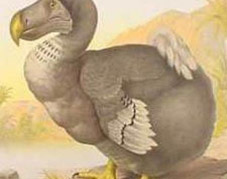E-Activity – Remix and reflection
Dodo
The Dodo (Raphus cucullatus) is an extinct flightless bird that was endemic to the island of Mauritius, east of Madagascar in the Indian Ocean. Its closest genetic relative was the also extinct Rodrigues Solitaire, the two forming the subfamily Raphinae of the family of pigeons and doves. The closest living relative of the Dodo is the Nicobar Pigeon. A white Dodo was once incorrectly thought to have existed on the nearby island of Réunion.
Reference:
Wikipedia (http://en.wikipedia.org/wiki/Dodo)
(Retrieved on 16 September 2013)
Creative Commons License: Creative Commons Attribution-Share Alike License

Remake of 1626 painting by Roelant Savery
Reference:
http://a-z-animals.com/animals/dodo/pictures/3963/
(Retrieved on 16 September 2013)
A brief history of the dodo
The Dodo were huge birds of unknown species that existed only on the island of Mauritius which had no human habitation prior to 1598. Due to its short wings and bulky body the dodo could not fly or flee in the face of danger.
For many years people have been using the above description when referring to the Dodo. However, new research carried out in the United Kingdom has revealed two important things we did not know before about this extinct bird.
Firstly, the Dodo came from a distant family of Asian pigeons. Secondly, they were not so huge and bulky in their natural habitat as was commonly thought of.
Those birds had no experience of any types of predators before the arrival of settlers in the island. They were passive creatures even when approached by human visitors for the first time. So it was with lack of fears and child-like innocence that those birds greeted the first settlers, the Dutch, in 1598.
The story of the Dodo is indeed a tragic one. Firstly, human visitors, mainly the Dutch, used to kill them for food. Those that survived became prey to animals such as pigs, rats and monkeys that had been introduced into the island by sailors. By the year 1681 the last Dodo had died. The manner in which the Dodo were obliterated from the surface of the earth has left a lasting impact on the natural history of our global eco-system: in fact a lesson in extinction to humanity. So much so, that the English expression 'As dead as the Dodo' had to be coined to emphasize the concept of total annihilation or non-existence (by death) of something, or someone, or some idea, either in the literal or abstract sense.
Reference:
http://www.mauritiusdelight.com/dodohist.htm
(Retrieved on 16 September 2013)
Copyright - All Rights Reserved
Findings
In October 2005, Dutch and Mauritian researchers found a cache of 2,000-year-old bones from about 20 dodos in Mauritius. These findings were made public in December 2005 by Naturalis, the Netherlands scientific institute in Leiden. The discovery was significant because of the scarcity of specimens today. The last complete stuffed bird burned in a fire at Oxford's Ashmolean Museum in 1755. As of 2006, no complete skeleton has ever been found.
Though no whole specimens are preserved, a number of museum collections contain dodo skeletons that are composites, made up of the bones of different birds. A dodo egg is on display at the East London[ Museum in South Africa. The most complete remains of a single dodo are a head and foot, on display at the Oxford Museum of Natural History. Analysis of genetic material recovered from this specimen revealed that the dodo was a member of the pigeon family and its closest living relative is likely the Nicobar pigeon (Caloenas nicobarica) from the Nicobar Islands and nearby Southeast Asia (Shapiro 2002).
Reference:
New World Encyclopedia
http://www.newworldencyclopedia.org/entry/Dodo
(Retrieved on 16 September 2013)
Creative Commons License: Creative Commons Attribution-Share Alike License

Contents on this blog is available under Creative Commons Attribution-ShareAlike 3.0 Unported License.
Reflections
I used two articles under Creative Commons license BY-SA, one resource (image) in the public domain, and an All Rights Reserved work used here under Fair use as per Mauritius copyright act 1997. Even after research research on the internet, I was unable to find articles on "Dodo" published under other different Creative Commons license types. Since all the articles under creative commons licenses has the restrictions Share Alike (SA), all the works that follows contain the same term of use thus limiting I search. I even came across several articles more precisely image which I wasn't sure about their licenses. So to be on the safe side, I preferred to chose an image from the public domain.
Although this activity was very time-consuming as I spent more than 2 hrs searching for suitable articles and images, I believe it was an enriching experience for me where I got to learn news things about copyright and creative commons. This activity has also allowed me to read a bit about the "Mauritius copyright act 1997" which I was totally unaware.
I have registered this post registered with Creative Commons under CC Attribution-Share Alike license (CC BY-SA). This allow people having access to this post to copy, distribute, display and perform my copyrighted work – and derivative works based upon it – but only if they credit me in their work. People will also be able to use this post for commercial purposes as I believe this post contains interesting facts about dodo and can be use to promote Mauritius island worldwide. This give me the feeling that I am taking part in my community by promoting my beloved island.




